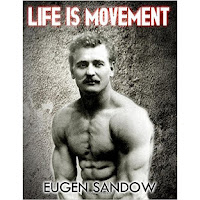Dumbbells can- and should- be an integral part of any serious strength-training program. For competitive Lifters looking to increase their strength, dumbbells are an excellent way to increase overall body strength, which will translate to success on the lifting platform. For those who seek to increase their muscular size and mass, dumbbells have been a proven bodybuilding tool for many decades.
Many trainees, myself included, were introduced to weight training through the use of dumbbells. I vividly recall my early workouts with a pair of 14" adjustable dumbbells with plastic weights and collars. And even though we've all progressed to various other training modalities, dumbbells still play an important role in my training. And rightfully so. You can build great strength and power with heavy dumbbell training.
For many beginners who train at home, one disadvantage of dumbbells is having to change more plates than when using a barbell. This is one time when training in a commercial gym may be an advantage over training at home. Most gyms will have a large selection of fixed ( or pre-loaded ) dumbbells from which to choose. Of course, if you have the space, you can obtain a collection of fixed dumbbells for your home gym.
Another reason why some people avoid using dumbbells is that, pound for pound, dumbbells are more difficult to handle than a barbell. The reason for this is quite simple. Lifting a pair of dumbbells makes it necessary to control each one individually. This is the opposite of handling a barbell, which is lifted as a single unit. Sometimes, one arm may be slightly weaker than the other, which means that one arm may falter or lag during an exercise. Even if both arms are equal in strength, a lack of concentration can cause the same thing to happen.
There is one more reason why some people avoid dumbbells. Some movements, like the Bench Press or Incline Press, require the help of one or more spotters just to get the dumbbells in the proper starting position. Even cleaning a pair of dumbbells to the shoulders for a standing Press can be tricky, especially for a beginner. However, learning to get a pair of heavy dumbbells to the shoulders is an important skill to master. Lifting heavy dumbbells is an excellent way to build good, rugged power.
There are two ways to clean heavy dumbbells. You can either stand in between them, or your feet can be on the outside of the dumbbells. Personally, I prefer to stand between them, with the dumbbells on my sides. By keeping your back flat, and straight, drive with your legs and hips with a strong pull and bring the dumbbells in one sweeping motion to the shoulders. You can bend at the knees slightly to help get them to the shoulders. You want to keep the dumbbells close to your body and concentrate on pulling the dumbbells. You do NOT want to swing them. Once they're at the shoulders, then you're ready to do either strict Presses or Push Presses, whichever you prefer.
While I prefer doing strict Presses, you can also Jerk the dumbbells overhead. It may take a while to find out the precise timing and coordination while combining the slight leg dip while throwing the dumbbells overhead. If you re pressing them strictky, then you must keep the knees locked and push the dumbbells overhead with minimum arching of the back.
There is one very important thing to remember: Don't assume that just because you can Clean and Press a 250 Lb. barbell, that you should be able to handle 125 Lb. dumbbells in each hand. It doesn't work that way. The same goes for dumbbell Bench Presses. Like any other movement, you'll just have to determine, through trial and error, the correct amount of weight to use.
One thing that I've neglected to mention is that you don't necessarily have to lift the dumbbells overhead. Dumbbell Power Cleans are an excellent exercise just by themselves. You can develop great power doing heavy dumbbell Power Cleans. And, in my opinion, dumbbell Power Cleans are easier to do than Power Cleans with a barbell. And you will greatly increase the size and strength of your legs, back, arms, and shoulders. One of my favorite movements is dumbbell Power Cleans with my Ironmind thick-handled dumbbell bars.
For those of you who want to really push yourselves, I suggest the Sig Klein Dumbbell Challenge. As most of us know, or should know, Sig Klein is one of the legendary figures of the Iron Game. He was a Physical Culturist, gym owner, bodybuilder and one of the strongest men of the early 20th century. At a bodyweight of slightly over 150 Lbs., he was able to do twelve strict reps in the dumbbell Clean and Press. He felt that this was an accomplishment that few men could perform. A casual glance through a typical commercial gym would prove that he is still correct today. Anyway, here is the challenge:
Take two 75 Lb. Dumbbells and Clean and Press them for 12 perfect reps. Perform a separate Clean and Press for each rep. The Press has to be strict. Legs locked, back straight, complete lockout. While it may not seem very daunting on paper, after a few reps, most people will quickly realize that it is harder than it looks. Much harder.
Whether your goal is to challenge the great Sig Klein, or simply build more size, strength, and power, learning to lift heavy dumbbells is a worthwhile endeavor .
Read More »

